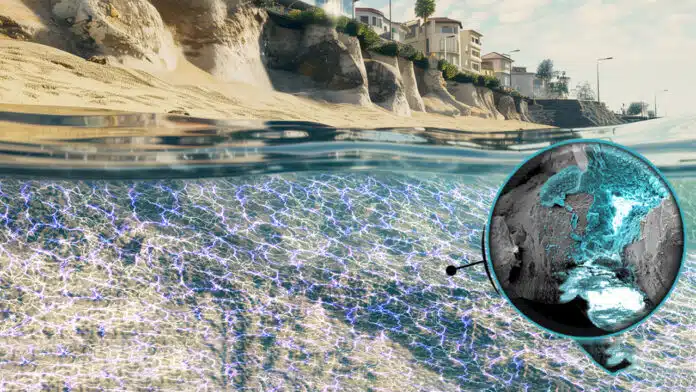
By Ashwini Sakharkar 23 Aug, 2024
Collected at: https://www.techexplorist.com/mild-electricity-help-fight-coastal-erosion/87757/
The erosion of marine sediments poses a critical threat to coastal areas globally. Conventional methods for combating coastal erosion have failed to deliver long-term and sustainable solutions to safeguard marine ecosystems.
However, groundbreaking research from Northwestern University has demonstrated that a gentle application of electricity can fortify a marine coastline for generations, significantly diminishing the risks of erosion posed by climate change and rising sea levels.
In this innovative study, researchers drew inspiration from the natural shell-building process of clams, mussels, and other shell-dwelling marine life. Clams, mussels, and other shell-dwelling marine life utilize dissolved minerals in seawater to construct their protective shells. Mirroring this natural phenomenon, the research team harnessed the power of naturally occurring dissolved minerals to create a natural cement binding between sea-soaked sand grains.
Instead of relying on metabolic energy like mollusks, the researchers utilized electrical energy to catalyze this chemical reaction.
In laboratory experiments, a mild electrical current swiftly altered the composition of marine sand, effectively turning it into a rock-solid, immovable substance. This innovative technique has immense implications, potentially providing a long-term, cost-effective, and eco-friendly solution for fortifying shorelines worldwide.
“Over 40% of the world’s population lives in coastal areas,” said Northwestern’s Alessandro Rotta Loria, who led the study. “Because of climate change and sea-level rise, erosion is an enormous threat to these communities. Through the disintegration of infrastructure and loss of land, erosion causes billions of dollars in damage per year worldwide. Current approaches to mitigate erosion involve building protection structures or injecting external binders into the subsurface.
“My aim was to develop an approach capable of changing the status quo in coastal protection — one that didn’t require the construction of protection structures and could cement marine substrates without using actual cement. By applying a mild electric stimulation to marine soils, we systematically and mechanistically proved that it is possible to cement them by turning naturally dissolved minerals in seawater into solid mineral binders — a natural cement.”
The earth’s coastlines are under threat from the ravages of climate change, with intensifying rainstorms and rising sea levels causing widespread erosion. Shockingly, a 2020 study by the European Commission’s Joint Research Centre predicts that nearly 26% of the world’s beaches will be lost by the end of the century.
Communities have scrambled to combat this looming crisis, resorting to two main strategies: building protective structures like sea walls or reinforcing marine substrates with injected cement. However, these conventional methods are not just exorbitantly expensive, they are also disturbingly ineffective in the long run.
Even seemingly sturdy sea walls are not immune to erosion, as the sand beneath them gradually washes away and leaves them vulnerable to collapse. Meanwhile, the process of injecting cement into the ground comes with irreversible environmental consequences and demands massive energy inputs. It’s clear that we cannot continue down this unsustainable path.
In an innovative approach to address these challenges, Rotta Loria and his team have pioneered a revolutionary technique, drawing inspiration from the remarkable resilience of coral and mollusks. By harnessing the abundant ions and dissolved minerals naturally present in seawater, they have devised a method employing a gentle electrical current (2 to 3 volts) to induce powerful chemical reactions.
This transformative process effectively converts select constituents into solid calcium carbonate, the very same mineral utilized by mollusks in the construction of their robust shells. Moreover, by applying a slightly higher voltage (4 volts), these constituents can predominantly morph into magnesium hydroxide and hydromagnesite, a mineral widely dispersed in various stone formations.
The resulting minerals, when combined with sand, act as a natural adhesive, effectively binding the sand particles together. Remarkably, this innovative process has proven successful across diverse sand types, ranging from commonplace silica and calcareous sands to more niche iron sands commonly found in proximity to volcanic activity.
“After being treated, the sand looks like a rock,” Rotta Loria said. “It is still and solid instead of granular and incohesive. The minerals themselves are much stronger than concrete, so the resulting sand could become as strong and solid as a sea wall.”
While the minerals form instantaneously upon the application of electrical current, prolonged stimulation yields even more substantial and enduring results.
“We have noticed remarkable outcomes from just a few days of stimulations,” Rotta Loria said. “Then, the treated sand should stay in place without needing further interventions.”
Rotta Loria has predicted that treated sand will be crucial in safeguarding coastlines and properties for decades to come. Not only is this process durable, but it also boasts a remarkable level of reversibility – a simple switch of the anode and cathode electrodes can effectively undo the solidification. Furthermore, the minimal impact on sea life and the potential to strengthen undersea structures and restore coral reefs make this method highly promising.
The process offers a cost-effective alternative by costing only $3 to $6 per cubic meter, compared to up to $70 for similar methods. It can heal cracked reinforced concrete structures in shoreside infrastructure, eliminating the need for full reconstruction. Just one pulse of electricity can mend potentially destructive cracks.
“The applications of this approach are countless,” Rotta Loria said. “We can use it to strengthen the seabed beneath sea walls or stabilize sand dunes and retain unstable soil slopes. We could also use it to strengthen protection structures, marine foundations, and many other things. There are many ways to apply this to protect coastal areas.”
Next, Rotta Loria’s team plans to test the technique outside of the laboratory and on the beach.
Journal reference:
- Andony Landivar Macias, Steven D. Jacobsen & Alessandro F. Rotta Loria. Electrodeposition of calcareous cement from seawater in marine silica sands. Communications Earth & Environment, 2024; DOI: 10.1038/s43247-024-01604-3

Leave a Reply